Share this
The Best Social Commerce Platforms In 2024 with Benchmarks
by Rin Mosher on Jan. 19, 2024

Social media is no longer just for sharing photos and status updates – the widespread introduction of in-house shopping features is turning apps like Instagram, TikTok, and Facebook from just social media into social commerce platforms, redefining the way consumers shop online. As an ecommerce business, you can take advantage of this in a big way.
This article runs through everything ecommerce brands need to know about social commerce, from what it is and how it works to how social commerce competitors square up against each other with benchmarks — all so you can find the best social commerce platforms for your business.
What Is Social Commerce?
Social commerce, or social media commerce, refers to the use of social media platforms to promote and facilitate the selling of products or services.
Social media platforms are arguably the best place to find willing online buyers today. Research firm Forrester found that roughly 61% of US adults younger than 25 have purchased products using a social commerce platform in 2021, up from 53% the year prior.
And those numbers are only going up – Accenture anticipates social commerce opportunities will triple by 2025.
Social Commerce vs. Ecommerce: What's the Difference?
Social commerce combines traditional ecommerce with social media to create an interactive shopping experience.
The defining characteristic of social commerce platforms is that they aren’t built for the sole purpose of online shopping. While popular marketplaces like Amazon were created to help people buy and sell products, social media apps mainly exist to connect friends and engage audiences with content. Shopping features complement the experience but aren’t the only reason users log in.
With that being said, ecommerce companies benefit greatly from having a presence on social commerce platforms.
Benefits of Social Commerce Platforms
Below, we explore the many reasons why this emerging approach to ecommerce is gaining so much traction.
An Organic Approach to Advertising
Social media’s recreational nature creates opportunities for brands to connect with audiences in a less sales-y, confrontational way. You have the opportunity to lead people through a new kind of purchasing process with less risk of ad blindness and ad fatigue.
Strong Social Proof
The concept of ‘social proof’ stipulates that people are more likely to trust a product or service if they see others using and enjoying it. By seeing positive reviews, comments, and likes from their friends and family members, customers have the assurance they need to make an educated purchase decision.
Studies have further shown that people tend to trust the recommendations of those they follow, which makes influencer marketing an effective way for companies to reach new audiences and create brand awareness through social media. Brands can tap into influencers’ large followings to reach potential customers who may not have discovered their product pages otherwise.
In-app Shopping Convenience
Research reveals that the power of social platforms for brands goes beyond awareness generation - it drives sales. 54% of people surveyed by Facebook IQ say they’ve made a purchase either in the moment or after seeing a product or service on the app before.
Part of this is attributable to integrated checkouts that lessen the number of pages, buttons, and form fields users have to click through to make a purchase. Another is the timeliness of product posts and ads, which can be configured to appear alongside relevant content in people’s feeds.
Powerful Exposure and Engagement
Community growth is much harder to create when the audience you’re speaking to is limited by an email list. It requires getting the attention, opinions, and feedback of people beyond your user base and creating shopping experiences that impress them - even if they’re not ready to buy just yet. Social commerce features empower brands to engage relevant audiences in a number of ways. Comments, personalized stories, polls, and surveys, for example, can all be invaluable when it comes to both exciting existing customers and piquing the interest of new ones.
Social Commerce Platform Benchmarks
The question of which social commerce platform is best for your business could have multiple answers. Every option has proven to be a profitable sales channel with the right approach - it's ultimately a matter of aligning your efforts with the right audience.
To that end, Facebook is widely considered the most worthwhile place to spend your time as an ecommerce brand this year. Survey data from Statista shows the social network is nearly one-third of global online shoppers' first choice, followed by Instagram at 24%.
A recent forecast from eMarketer predicts Facebook's share of consumers will only grow further heading into 2024, to roughly 64.6 million people. This group of users is relatively diverse, but generally 35 and older - a demographic that boasts significant buying power.
As for younger consumers, a majority of Gen Z considers Instagram their platform of choice, while nearly half now use TikTok to make purchases online.
Experts predict TikTok will reach 107.8 million users in 2024, a five percent year-over-year increase. Much of that growth is attributable to people under 25. In fact, as much as two-thirds of TikTok's user base is aged 18-19.
Analysis shows that TikTok is currently growing at a much faster rate than its counterparts in the social commerce space. The app acquired a whopping 11.6 million shoppers in 2023, which is more than the net increase of Facebook, Instagram, and Pinterest combined (6.4 million). While it may cater to younger audiences, TikTok's expanding popularity across the board and latest headway in the social commerce realm make it a platform that all businesses should start paying attention to.
See the next section for a more detailed breakdown of the most-used social commerce platforms today and what each has to offer.
The Best Social Commerce Platforms
Several well-known social media platforms have expanded their features over the years to include in-app social shopping experiences. We explore a few of the most popular social commerce platforms below.
Everyone knows what a Facebook page is - businesses have been using them to connect with customers for two decades. With the launch of Facebook Shops in May 2020, Facebook pages have become even more of a powerful selling tool.
How Social Commerce Works on Facebook
With Facebook Shops, merchants can set up their own online storefronts directly within Facebook and showcase their products natively within the app. Everything from color to font type is customizable, and flexible item listing settings allow shoppers to browse individual products as seamlessly as they would in a traditional online store.
When to Use Facebook Shops for Ecommerce
Two decades after its release, the adults who first adopted Facebook in the early 2000s still prefer to keep in touch with friends and family on the platform; more than one-third of Facebook's user base is older than age 45 as of 2023. Meanwhile, research conducted by Creating Results shows that 60 percent of adults over the age of 55 on social media open Facebook at least once a day. This makes it an excellent place to focus your efforts when selling to older audiences.
Originally an image-based platform, Instagram has always been ideal for businesses selling products and services with visual appeal. Its evolution into a space of photo, video, 24-hour, and carousel content over the years presents even more value for ecommerce companies.
Now, brands have the ability to promote themselves and their products in several ways - through organic uploads, user-generated posts, collaborations, and more.
How Social Commerce Works on Instagram
Meta introduced Instagram Shops alongside Facebook Shops in 2020. The two social commerce platforms can be independent in terms of catalog content but are ultimately connected by one set of login credentials. Instagram’s shopping features are similar to Facebook’s, allowing merchants to create custom storefronts on their profile pages. Products are mixed into users’ browsing experience a little differently, however; there’s a dedicated Shop page as well as spaces for items on the Explore page.
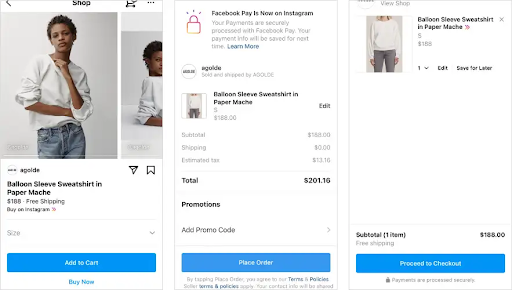
When to Use Instagram for Ecommerce
Over 75% of Instagram's audience is younger than 45 years old, making it a great place to connect with Millennials and Gen Zers. These individuals have been studied for their digital shopping habits and are known to make more purchases through social media than other platforms. They're furthermore likely to respond to lifestyle-focused, influencer-driven marketing.
Boohoo offers a great example of what can happen when this is recognized and used to its full potential. The athleisure company has spent tens of millions of dollars on influencer marketing over the years to accumulate just as many followers and sales as a result. Leaders attribute much of their revenue growth in 2020 and 2021 to investments in Instagram and other Gen Z-targeted marketing channels.
TikTok
Video giant TikTok is gaining traction in social commerce thanks to the recent launch of TikTok Shop, which acts as an extension of businesses' existing presence on the video-sharing app.
How Social Commerce Works on TikTok
Business accounts can configure their storefronts to display individual items and catalog collections, link directly to products within posts, and even host shoppable livestreams. That’s in addition to the many means by which brands have used TikTok for ecommerce before Shop, like partnerships with influencers, paid ads, and hashtags.
The best thing about TikTok’s shopping features is how seamlessly TikTok Shop integrates into a user’s browsing experience. Products can be directly linked to from videos and live streams while brands have complete control over how catalogs look on their account profiles. The only real obstacle to overcome is establishing a reliable TikTok Shop fulfillment system.
When to Use TikTok Shop for Ecommerce
TikTok Shop’s seamless, built-in payment process allows buyers to make purchases within a matter of seconds without having to leave the app. You would be best off choosing this social commerce platform when marketing to people between 15 and 38 years old, as they make up the majority of TikTok's user base.
The key is to create content that resonates with your company’s target audience. Scrub Daddy, Squishmallows, and Gymshark have all amassed huge followings on TikTok by being personal, fun, and relatable.
@scrubdaddy Scrub Daddy on a stick…. Who would’ve thought?? #scrubdaddy #smile #cleantok #cleaningtiktok #americasfavoritesponge
♬ original sound - Scrub Daddy
Snapchat
Snapchat is a popular social media app that allows users to share photos, videos, and messages with their friends. Since its launch in 2011, teenagers and young adults have made it one of the most popular social channels out there.
How Social Commerce Works on Snapchat
Snapchat has been experimenting with different features since 2016 and since evolved to offer businesses a full-fledged suite of social selling tools, including shoppable product catalogs, branded AR filters and lenses, virtual ‘try-on’ tools, and in-app checkouts.
When to Use Snapchat for Ecommerce
Most popular among 15 to 25-year-old online shoppers, Snapchat is an attractive social commerce platform for brands looking to sell generally low-cost and trend-driven items.
Its in-the-moment nature also works well for marketing campaigns that aim to take advantage of micro-trends.
You’ll often see ecommerce companies use branded face filters to promote the launch of a new product line or celebrate a specific event. For example, the company behind VTAMA® (Tapinarof) created a lens simulating the lifting effects of its skin cream. Maybelline New York also has several branded filters that allow Snapchat users to explore their various types of mascara.
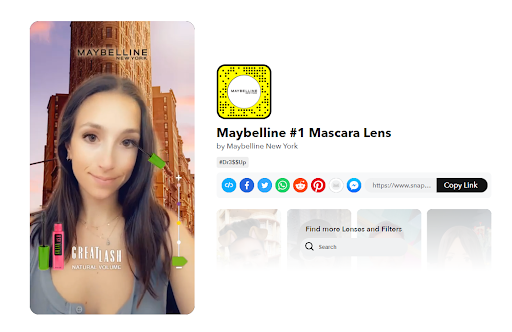
Pinterest is a platform designed to stimulate idea-sharing across niche creative communities. Its base of 400 million users spans the globe, connecting individuals of every interest through photos and Pins.
How Social Commerce Works on Pinterest
The Pinterest app has free and paid solutions to facilitate online shopping, most notably Product Pins. These are snippets of metadata that display pricing information, availability, and specifications from a connected online store. If users like what they see, they can easily click through to purchase items on the merchant’s main site.
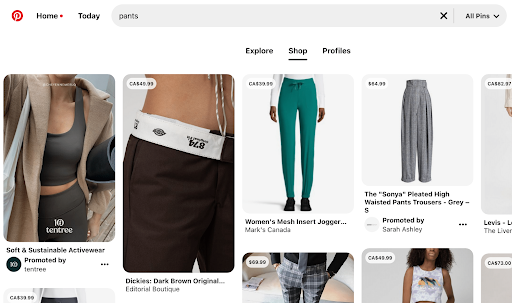
Catalogs act as a central repository for all of a brand’s products, but ecommerce content can be found in other parts of the app as well. Pinterest allows businesses to create shoppable posts and video content promoting organic product discovery. It also recommends products related to what users browse in real-time.
When to Use Pinterest for Ecommerce
This social network mainly consists of people looking for visual inspiration or a real-world perspective of products they’re considering buying. It’s estimated that 45% of individuals in the United States with a household income of $100,000 or more are on Pinterest. These users are more likely to be interested in purchasing higher-priced products than those on micro-trend-driven platforms like Snapchat.
Pinterest’s social features offer added value by enabling brands and users to directly engage with one another. The most followed account on Pinterest goes beyond promotional content to offer followers free fashion and design advice with Idea Pins.
What Does the Future of Social Commerce Look Like?
Social media platforms are pioneering a new era of ecommerce with the introduction of features unlike anything consumers have seen before. In 2024, we can expect to see a growing focus on real-time engagement, virtual shopping experiences, and innovative social commerce solutions that provide a more personalized experience for buyers.
Augmented Reality (AR)
Augmented Reality is a quickly developing technology that's sure to have a formative impact on the ecommerce industry. AR allows customers to virtually try on clothes, makeup, and accessories by overlaying images directly onto themselves.
Puma, American Eagle, and Zenni Optical recently became some of the first brands to try out virtual product try-ons with Snapchat. With these, a social media user can superimpose items, like glasses, onto themselves before making a purchase. This adds a level of personalization to the in-app shopping experience while also increasing consumers’ confidence before they hit the buy button.
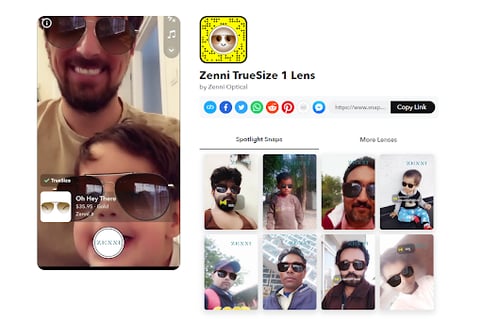
Pinterest also offers try-on experiences for select products like makeup. Users can click on Product Pins to virtually sample lipstick, eyeshadow, and more to ensure it matches their style and skin tone before making a purchase decision.
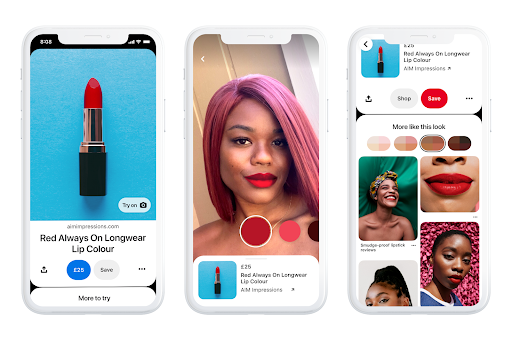
Image courtesy of Pinterest
Creator Programs
Social media platforms have taken notice of the large number of brands that use their app to promote products and are now rolling out programs designed to facilitate collaboration between brands and influencers.
This is a great way for brands to tap into the personal nature of social media while leveraging the reach these creators have with online audiences. Paid partnerships and sponsored content are becoming more and more common — and likewise easier to publish — across Instagram, Facebook, TikTok, and many more.
Shoppable Livestreams
Live streaming has been popular on social media for a while now, but it's becoming even more interactive with the addition of shoppable content. Shoppable Instagram Lives and Shoppable TikTok LIVEs allow brands to showcase their products in real-time and give viewers the ability to purchase items as they watch. This level of convenience is even more powerful when it's combined with time-sensitive promotions like exclusive deals and limited edition products.
How to Get Started With Social Commerce Platforms
Getting started with social commerce is easier than you might expect - the process begins as soon as you choose the platforms you'd like to use. You'll then need to create a business account on each platform or convert an existing one if you already have a personal account.
Once your accounts are set up, you'll need to populate your storefront by connecting it with an ecommerce site. This will allow customers to find and purchase the products you're selling.
You should also arrange fulfillment and shipping so that you can get products to customers quickly.
A third-party logistics (3PL) service provider can help alleviate the logistical nightmare of picking and packing social commerce orders. Just be sure to choose a reliable partner to work with, as not every company is made equal.
Need a 3PL Provider?
Done right, social commerce can help you build relationships with customers, increase brand awareness, and drive sales beyond what conventional ecommerce sites have to offer. Success is simply a matter of developing the right strategy - one that’s ready for what the future of social selling has to hold. The more seamlessly you can set up shop on platforms like Instagram and TikTok, the better chance you have of capitalizing upon their newfound dominance in ecommerce.
As an industry-leading 3PL service provider, Shipfusion is equipped with the technology and infrastructure your business needs to operate sustainably on social commerce platforms. Learn more about our TikTok Shop fulfillment services.
Share this
You May Also Like
These Related Articles

Your Complete TikTok Ecommerce Strategy Guide For 2025

How to Sell On Facebook as a Business In 2025
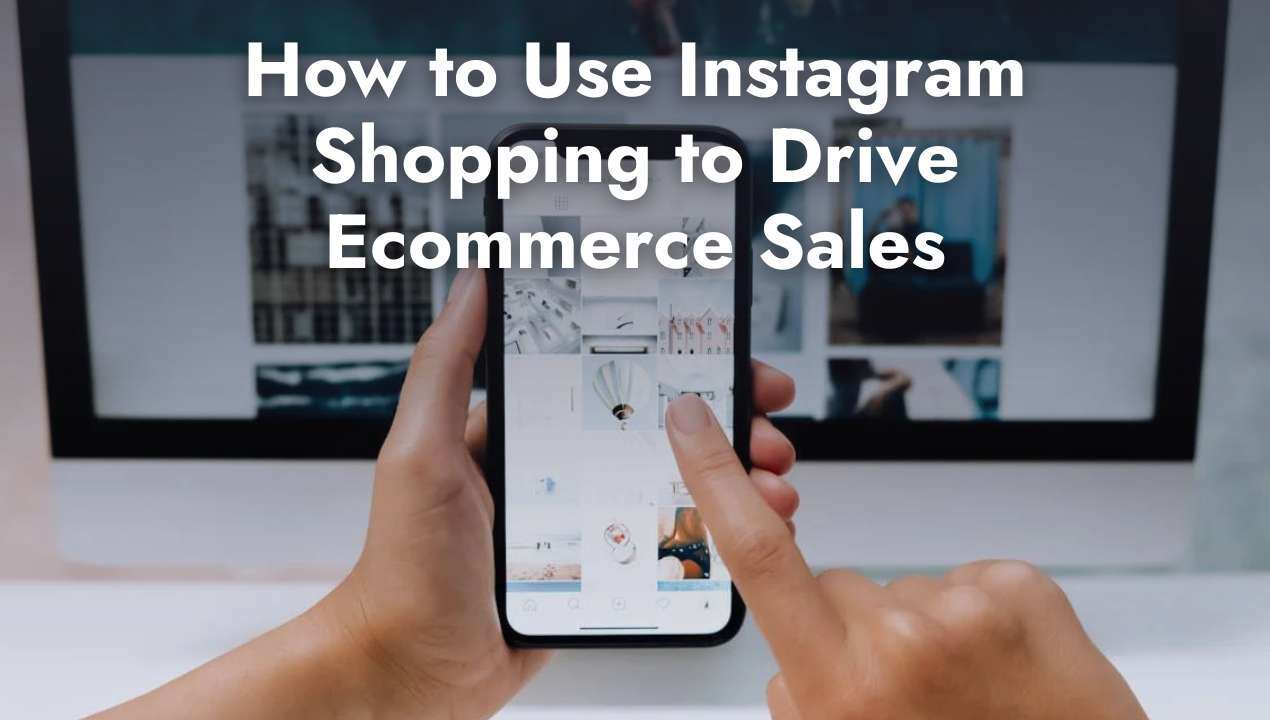
How to Use Instagram Shopping to Drive Ecommerce Sales
- April 2025 (18)
- March 2025 (26)
- February 2025 (26)
- January 2025 (37)
- December 2024 (16)
- November 2024 (23)
- October 2024 (22)
- September 2024 (27)
- August 2024 (9)
- July 2024 (8)
- June 2024 (5)
- May 2024 (8)
- April 2024 (8)
- March 2024 (6)
- February 2024 (6)
- January 2024 (5)
- December 2023 (3)
- November 2023 (3)
- October 2023 (5)
- September 2023 (4)
- August 2023 (2)
- July 2023 (1)
- June 2023 (4)
- March 2023 (2)
- October 2022 (1)
- September 2022 (5)
- August 2022 (4)
- July 2022 (7)
- June 2022 (4)
- May 2022 (4)
- April 2022 (6)
- March 2022 (2)
- February 2022 (1)
- January 2022 (3)
- December 2021 (2)
- November 2021 (4)
- October 2021 (2)
- September 2021 (5)
- August 2021 (4)
- July 2021 (4)
- June 2021 (3)
- May 2021 (2)
- April 2021 (3)
- March 2021 (3)
- February 2021 (3)
- January 2021 (2)
- December 2020 (4)
- November 2020 (2)
- October 2020 (4)
- September 2020 (2)
- July 2020 (5)
- June 2020 (4)
- May 2020 (2)
- April 2020 (2)
- March 2020 (4)
- February 2020 (1)
- December 2019 (1)
- May 2018 (1)
- March 2018 (2)
- February 2018 (3)
- January 2018 (3)
- November 2017 (3)
- July 2017 (4)
- March 2017 (3)
- February 2017 (5)
- January 2017 (3)
- December 2016 (4)
- November 2016 (6)
- October 2016 (6)
- October 2015 (1)
- September 2015 (1)
- June 2015 (3)
- May 2015 (3)
- August 2014 (1)
- July 2014 (1)
- March 2014 (1)
- February 2014 (1)